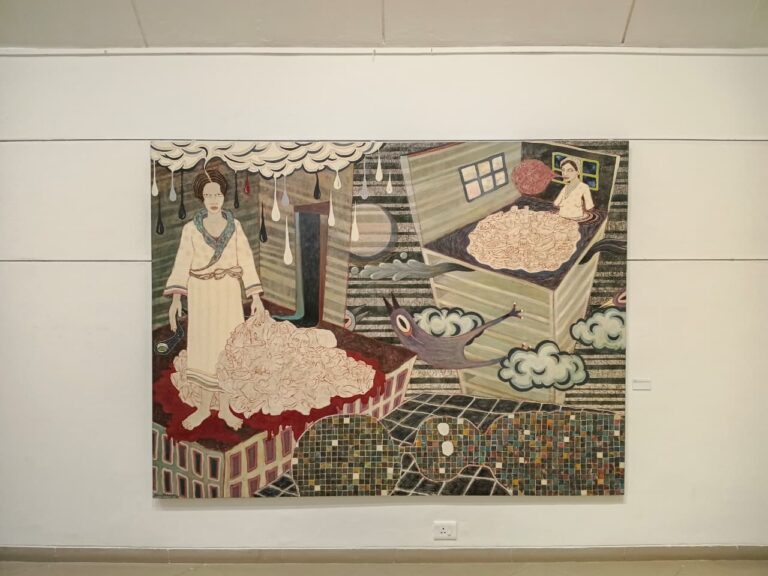Introduction text by Dr. Seema Bawa
Satish Gujral is one of the rare artists who starting exhibiting in the early 50s and continues to do so today. He had his first show in Delhi at the Free Mason’s Gallery in 1952, and the latest show in 2009 at Cymroza in Mumbai.

He has been at the centreof the changing Indian art scene, especially in Delhi, as a participant, as a witness and as a critical onlooker for over five decades. Just a cursory look at his works reveals the history of modern Indian art, while an in depth analysis and conversation with the artist reveals the hidden history of Indian artists. Tucked away in his very alert mind are not only observations on the nature of art and art practice but also on the events and personalities who reverberate in Indian art through episodes and anecdotes narrated by Gujral.

His early catalogues are revealing of the artists originality of ideas and the response they evoked; and also of his proclivity towards change, as he transformed his ideas, his style and the very vocabulary of expression in every series, a fact noted by his contemporaries. By the time he exhibited in the Forum Art Gallery on Madison Avenue in New York in 1964, he already had an enviable string of reviews by leading art critics and ideologues replicated in the catalogue. These included internationally acclaimed writers such as John Berger and Brian O’Doherty to Indian doyens such as Vatsain, Charles Fabri and Richard Bartholomew.

The catalogue itself seems sparse and small by today’s standards of lavishly produced book-catalogues but indeed the all colour Forum catalogue is the most definitive in comparison to the previous ones. It was produced at a time when catalogues even in two tone colour were a rare luxury. The artist recalls that in one of the earliest group shows of Eight Artists, held in 1968, including Mohan Samant, Krishen Khanna, K. S. Kulkarni, Gaitonde, Ram Kumar, M F Husain and Gujral the catalogue sponsored by Rockefeller was a slim affair and was the priced at 25 paise and indeed on one of the disappointing days was the only thing that sold! Buyers and collectors, especially in Delhi were few and far in between and it were the diplomats who bought art works and therefore had quite a powerful presence in the art scene. Not that the prices of art works were high but economic and cultural constraints that determined the purchasing power and the desire to acquire art remained till the 1980s.

Let alone catalogues, even display space was a sparse commodity. AIFACS was controlled by Barda Ukil and was not available for those who did not bask in the glory of Ukil’s approval. And Satish Gujral did not have the requisite approval because of his independent thinking; therefore he had to exhibit in alternate spaces such as the Free Mason Hall, Modern School Barakhamba and of course abroad. It is only with the formation of an alternate art centre, the Delhi Shilpi Chakra, mainly by artists who came from Lahore, that there shows could be held at its Shankar Market flat. Gujral survived and flourished because of the strength of his conviction and art; and he had remarkable contemporaries such as Charles Fabri, who not only appreciated and critically acclaimed this trait but also supported him in his struggle with Barda Ukil and clique. Satish Gujral recalls a time when Delhi was not a centre of art and culture, Calcutta and Bombay had the legitimacy, buyers and the luminaries. But 50s and 60s were a time of struggle, experimentation, experience, exuberance, camaraderie and evolution both for the city and the artist.

Charles Fabri: Satish Gujral’s Exhibition Catalogue
Forum Gallery, New York, April 1964
With trepidation and much hesitatingly I suggest that the one element that has now come out in Satish Gujral’s latest work is the most characteristically Indian contribution to the world’s art.
It is serenity, the tranquillity of the spirit, the meditating and almost philosophical attitude towards human existence. In his earlier work the most out- standing and telling element was arestless surge, a violent rebellion and a cataclysmic upheaval… Despair shouts from these old canvases, a rebellious clamour of violent forms, tearing the picture (and the deeply moved spectator) to pieces.

But his new style is as it were, the Indian answer.The surging and undulating and seething lines give place here to calm and tender lines: the wild impasse is as it were tamed,and quiet surface breaths tranquillity and even peace.This truly is something profoundly Indian: the courageous facing of facts,the philosophical attitude to the world of sorrows. Satish Gujral, it seems to me, has not only found this peace in his Indian self, he is also finding at the same time, a style all his own.
He is clear, lucid and uses symbolism (another Indian characteristic of art), with a perfectly clear aim. He says whatever he wants to say, with his usual power,in a straight forward and vigorous manner.One only hopes that this most welcome development will lead Satish Gujral to greater and greater heights. And that he will find in himself that peace we are all looking for and which the ancient Indian knew so well.
NOTE: The images and the text are part of Satish Gujral’s Forum Gallery Catalogue published in 1964.














